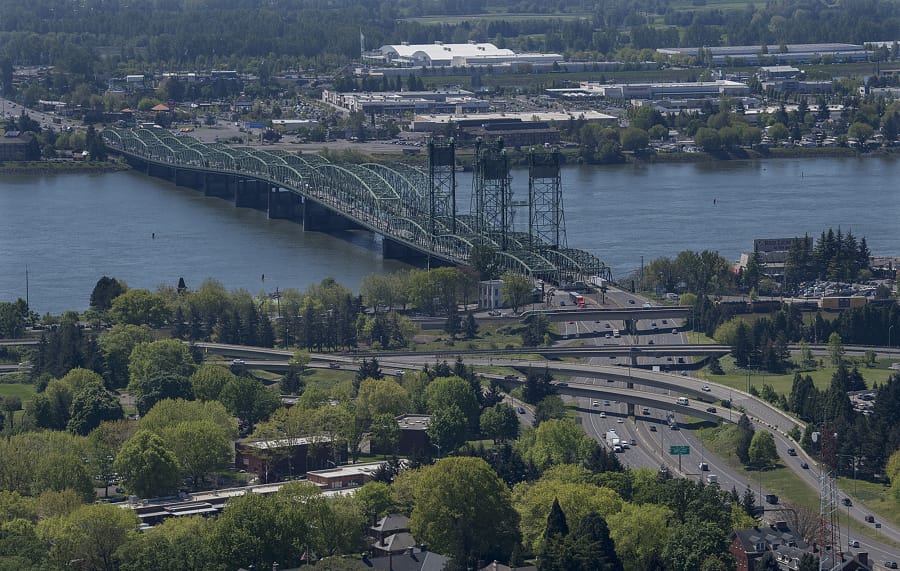The Vancouver City Council Monday evening took its first tangible step toward restarting a conversation that’s been ongoing for the last several decades: replacing the Interstate 5 Bridge.
Kris Strickler, Washington State Department of Transportation’s Southwest regional administrator, gave the council a primer of sorts on the bridge and how past project planning could be used going forward. The presentation largely stemmed from a bridge inventory prepared by WSDOT as directed by the Legislature. Senate Bill 5806 directed WSDOT to prepare an inventory of past bridge analysis and projects and also established a Joint Legislative Action Committee to consider a new I-5 bridge.
The committee is tasked with examining mass transit options and making a recommendation on process and financing to both the Washington and Oregon legislatures by Dec. 15.
As the inventory found, much of the prior analysis still stands. Congestion will continue to worsen and each year the maintenance on the current span costs $1.2 million.
Interstate 5 Bridge Facts and Figures
• By 2030, the number of trucks using the bridge is projected to increase 77 percent.
• The $40 billion worth of freight currently using the bridge is projected to increase to more than $70 billion by 2030.
• The operations and maintenance cost for the existing bridge is $1.2 million annually.
• Capital maintenance is estimated to cost about $300 million in planned maintenance by 2040.
• This is the only movable bridge along Interstate 5 between Canada and Mexico.
• Pre-construction testing cost $175 million during the project development period from 2005 to 2013.
• In 2005, there were 280,000 vehicle trips across the two spans daily. This is projected to increase 35 percent by 2025, with stop-and-go conditions 15 hours daily without improvements (7¼ hours southbound, 7¾ hours northbound).
• It is three to four times more likely for a vehicle collision to occur in the bridge corridor than other comparable urban areas.
Source: Washington State Department of Transportation
Replacing the bridge is still favored not because it’s necessarily cheaper, but because seismic retrofitting could cost upward of $600 million and won’t address any of the congestion issues.
Strickler explained that the seismic issue stems from the liquefiable layer of soil in the Columbia River. There’s a sizable risk that if an earthquake occurred with enough impact, the ground would turn to liquid and the bridge would sink. A new bridge could address the seismic concerns as well as mitigate congestion.
Project development for the failed Columbia River Crossing proposal identified five-lane spans as the preferred option. Three lanes would be used for drivers traveling through the region, and two lanes would accommodate drivers getting on and off the freeway near the bridge on either side of the state line. As Strickler noted, about 75 percent of drivers crossing the bridge enter or exit within five miles.
One of the biggest obstacles to moving forward with a project of this size is funding. The CRC plan identified a federal, state and user fee breakdown to fund the $3 billion project. The bridge alone was estimated to cost $1.2 billion.
“Many of these sources would change for any future funding project,” Strickler said.
Federal Transit Administration funds, for example, were spent elsewhere when Republicans in the Washington Legislature killed the project by refusing to provide the state match.
“We would have to get back in line for those,” he said.
Oregon’s role
Councilor Laurie Lebowsky brought up an issue that prevents any real discussion from moving forward — Oregon is not on board to restart bridge-replacement talks. For example, when Washington formed its legislative action committee to begin discussing the replacement process, representatives from Oregon were not present at the first meeting.
“Obviously we’re dealing with value pricing and Oregon is going their own way,” Lebowsky said. “I was thinking that maybe freight (mobility) might be a way to bring Oregon back to the table.”
WSDOT found that by 2030, freight traffic crossing the Columbia River will increase 77 percent.
Strickler said the Oregon Department of Transportation is a good partner. Strickler said when the time comes and project development begins, Oregon will rejoin the partnership.
Councilor Bart Hansen still questioned whether the city is premature in its optimism and timing when it comes to discussing a replacement project.
“We don’t have a very receptive Oregon in my opinion,” Hansen said. “This is going to take an effort above and beyond what we did before.”
What to do now
In the meantime, Councilor Ty Stober wondered if there is anything Washington can do to mitigate congestion.
“I want a new bridge. But I’m concerned because Vancouver is grinding to a halt right now and from my standpoint there are definitely mitigating things that could happen,” Stober said. “They may be painful things, they may irritate constituencies, but for the function of our city are there opportunities to be dealing with mitigation until we’re able to move forward?”
Essentially, yes, Strickler said. Nothing is yet in the works, but mitigation should be part of the discussion moving forward, he added. Mitigation could be as simple as adding variable speed signs to the interstate, something Oregon plans to implement in the future.
“I want to be clear, without a new bridge we are going to have significant congestion in this area, but we want to do everything we can,” he said.




